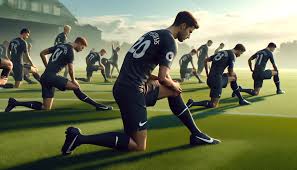In the high-octane world of professional football, every detail matters. From nutrition to sleep schedules, elite players leave no stone unturned in the quest to maximize performance. But one critical, often-overlooked component of their training regimen is stretching and not the kind you might remember from high school gym class.
Footballers at the top level use stretching as a science. It’s not just about flexibility it’s about enhancing performance, preventing injury, and speeding up recovery. Behind closed doors, there are stretching techniques and strategies used by the world’s greatest players that give them the edge on the field. Here’s a deep dive into the secrets of their flexibility routines.
Why Stretching Is More Than Just a Warm-Up
Stretching plays multiple roles in a footballer’s routine. It increases blood flow, improves muscle elasticity, and maintains joint health. But more importantly, it prepares the body to handle the explosive sprints, sudden stops, quick turns, and high-impact collisions that define modern football.
Without an advanced stretching protocol, even the most talented players are more vulnerable to soft-tissue injuries like hamstring pulls, groin strains, or torn ligaments — setbacks that can derail a career.
Dynamic Stretching: Game-Day Activation
Before stepping onto the pitch, players use dynamic stretching to warm up. Unlike static stretching which involves holding a pose for an extended period dynamic stretches involve active movement. These exercises prepare muscles for action and activate the central nervous system.
Some examples include:
- Leg swings: Forward and lateral leg swings improve hip mobility and hamstring readiness.
- High knees and butt kicks: These get the heart rate up while loosening up the hip flexors and quadriceps.
- Walking lunges with a twist: This targets the entire lower body while incorporating trunk rotation to engage the core.
- Carioca drills and bounding: These coordination-based drills are excellent for lateral movement, agility, and rhythm.
These exercises aren’t random they’re often selected based on the player’s position. A central midfielder might focus more on multidirectional mobility, while a striker may prioritize explosive lower-body movements.
Post-Match Recovery: Static and PNF Stretching
Once the game ends, the focus shifts to recovery and restoration. This is when static and PNF (Proprioceptive Neuromuscular Facilitation) stretching come into play.
- Static stretching involves holding muscles in an elongated position for 30–60 seconds. It helps lengthen muscle fibers, increase flexibility, and calm the nervous system.
- PNF stretching, however, takes recovery to a new level. It usually requires a partner or physiotherapist. The athlete contracts a muscle against resistance, then relaxes and stretches further. This technique dramatically improves range of motion and is especially effective for high-strain areas like the hamstrings, hip flexors, and calves.
Many top clubs incorporate these techniques into their post-game routines, often inside recovery rooms where players receive massages, use compression therapy, and hydrate all while going through carefully guided stretches.
Foam Rolling and Fascial Release
One of the biggest evolutions in modern recovery is the focus on fascia the connective tissue that surrounds muscles. When fascia becomes tight or inflamed, it can limit mobility and lead to pain or dysfunction.
To address this, footballers use:
- Foam rollers: To release tension in large muscle groups like quads, glutes, and calves.
- Massage guns: For targeted release of knots and tight spots.
- Lacrosse balls and trigger point tools: To access deep tissue areas and improve fascial glide.
By keeping the fascia healthy and supple, players reduce the risk of strains and improve their ability to move fluidly on the pitch.
Stretching Isn’t One-Size-Fits-All
Elite athletes have individualized stretching programs, designed by physiotherapists who assess their biomechanics, injury history, and movement patterns.
- A player with a history of groin injuries may do extra adductor stretches.
- Those recovering from ankle or knee issues might use mobility drills with resistance bands.
- Older players, like Cristiano Ronaldo, who continue to play into their late 30s and 40s, often devote significant time to joint mobility and spine flexibility.
The Long-Term Impact: Longevity and Legacy
Stretching isn’t glamorous, but it’s one of the reasons players like Lionel Messi, Zlatan Ibrahimović, and Cristiano Ronaldo have enjoyed such long, productive careers. Their commitment to flexibility and body maintenance helps them stay fast, fluid, and fit, even as their bodies age.
In fact, many top players now dedicate up to an hour a day to stretching, yoga, Pilates, or other mobility work a major shift from earlier generations where stretching was more of an afterthought.
Takeaway for Everyday Athletes
While most people don’t have access to a personal physio or a recovery room, everyone can learn from the pros:
- Warm up dynamically before workouts.
- Cool down with static stretches.
- Use foam rollers regularly.
- Focus on posture, balance, and joint mobility.
- Stay consistent results come over time, not overnight.
Final Thoughts
The stretching secrets of football’s elite are no longer just locker room whispers. They’re part of a larger revolution in sports science that recognizes mobility as a foundational pillar of performance. Behind every game-winning goal or heroic tackle is a body that’s been meticulously cared for stretched, mobilized, and prepped to move at the speed of the modern game.
If you want to play longer, recover faster, and reduce your risk of injury whether you’re a weekend warrior or an aspiring pro it might be time to take a page from football’s greatest.

